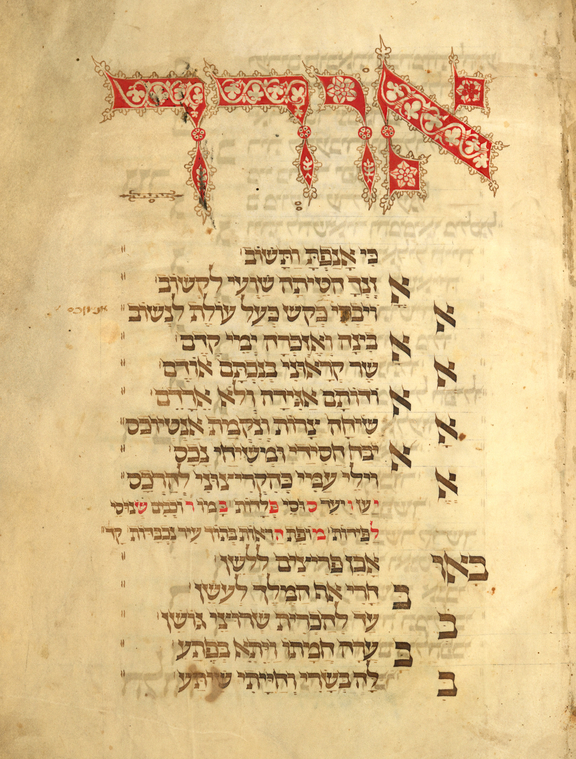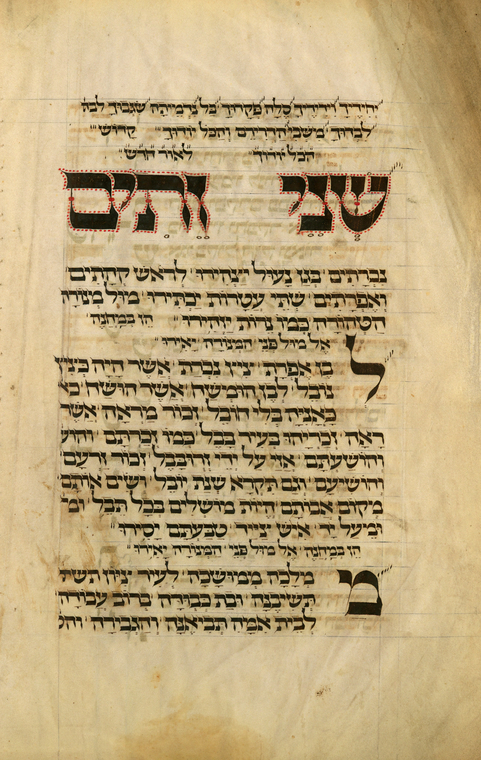Gems from the Dorot Jewish Collection: Two Chanukah Hymns From the Precious Medieval Manuscript Are As Stunning As Ever
It’s Chanukah time, the joyful holiday of light and resilience, celebration of the miracle of the oil, and it is a perfect occasion for us to shine a spotlight on some of the gems from the Dorot Jewish Division’s collections.
The Library’s stunning illuminated manuscript the David Bar Pesah Mahzor[i] was produced in Germany in the 14th century and is named after its scribe and decorator David Bar Pesah who was prominent for his distinctive style of iconography. The manuscript is also known as the Padua Ashkenazi Mahzor since it previously belonged to the Jewish community of Padua in Italy. The manuscript was donated to the NYPL by the manufacturer and philanthropist Louis Rabinowitz in the mid-20th century. The magnificent codex of 1,156 vellum pages bound in two solid volumes, in addition to standard liturgical texts, contains numerous examples of religious poems (piyutim) aimed to enhance festive synagogue services on the Holidays and special Shabbats, including two important poems for the Chanukah. Initial words of many prayers and poems in the Mahzor are marked with distinctive calligraphy in black and red ink, elaborative decorations, and, in some instances, exquisite full-page multi-color illuminated word panels.
One of the piyutim in the Mahzor is “Odekha ki anafta” (“I will praise You for though You were angry with me, Your anger was turned away”) is a hymn authored by the liturgical poet Joseph Ben Solomon of Carcassonne (France, 11th century). Written in the form of a ninefold alphabetical acrostic, it was traditionally performed on the first Shabbat of Chanukah. Its text is the author’s poetical rendition based on several sources, but mainly on Sefer ha-Makabim (Maccabees I) and the 10th century Sefer Josippon describing the disasters imposed on the Jews by the Greeks during the reign of Antiochus IV Epiphanes in 168 B.C.E. and the following defeat of the Greeks.
In the David Bar Pesah Mahzor, the poem opens up with a large initial word “odekha”. The four characters of the Hebrew word are featured in distinctive red ink adorned with sophisticated floral elements—tiny leaves and flowers placed inside and outside the letters. Beginnings of each line follow the order of the Hebrew alphabet. Because of the nature of this acrostic, each initial letter of the line is repeated nine times, but their positioning creates a sophisticated calligraphic pattern consistent throughout the entire poem.
Odekha ki anafta is followed by another Chanukah hymn intended to be performed at the second Shabbat of the Chanukah holiday—Shene zetim (“Two olive trees”). It was created by the famous Jewish philosopher and poet Solomon Ibn Gabirol (Spain, 11th century). The symbol of two olive trees evokes a connection to the Book of Zechariah traditionally read during this Shabbat. The two olive trees are mentioned as they stood on the left and right sides of the Menorah thus emphasizing the rededication and redemption of the Temple.
The initial two words are featured in large characters in bold black ink. They are framed with numerous tiny red dots that add significance and elegance to the representation of the poem. The initials of the author's first name are incorporated in the acrostic at the beginning of each stanza of the text.
It is astonishing to realize how these beautiful and fragile parchment pages of the medieval manuscript preserved colors as bright and gorgeous as the words of these Chanukah poems. The manuscripts and their content continue to resonate, enhance, and adorn our lives today, during the holidays, and beyond.
[i] Mahzor is a prayer book that contains liturgical texts as well as additional poems recited during the High Holidays (Rosh Hashanah and Yom Kippur). This term is also frequently used for the prayer books for other Jewish festivals.
Read E-Books with SimplyE
 With your library card, it's easier than ever to choose from more than 300,000 e-books on SimplyE, The New York Public Library's free e-reader app. Gain access to digital resources for all ages, including e-books, audiobooks, databases, and more.
With your library card, it's easier than ever to choose from more than 300,000 e-books on SimplyE, The New York Public Library's free e-reader app. Gain access to digital resources for all ages, including e-books, audiobooks, databases, and more.
If you don’t have an NYPL library card, New York State residents can apply for a digital card online or through SimplyE (available on the App Store or Google Play).
Need more help? Read our guide to using SimplyE.


Comments
Blog Essay posted by Dr. Lyudmila Sholokhova
Submitted by Fruma Mohrer (not verified) on December 11, 2020 - 3:50pm
Thank you
Submitted by Renate Evers (not verified) on December 12, 2020 - 6:06am
Odekha ki anafta
Submitted by Lyudmial (not verified) on December 15, 2020 - 10:43am